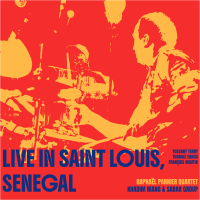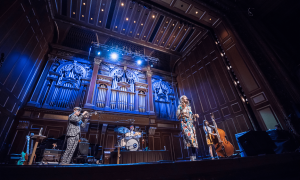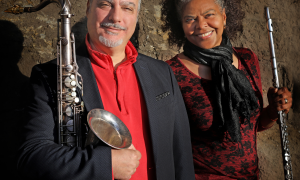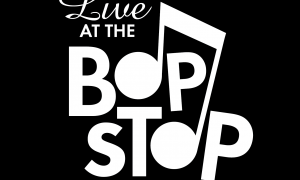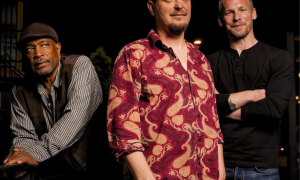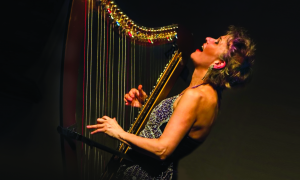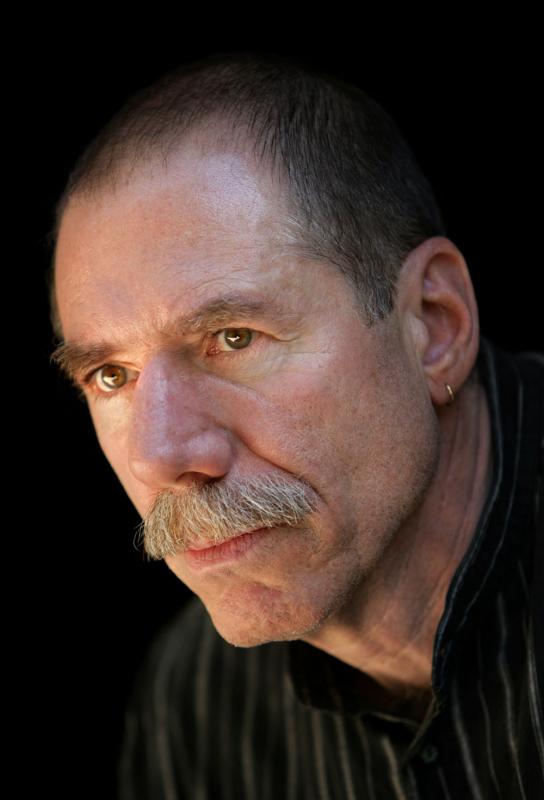
It's no secret that Giacomo Gates is among my favorite male jazz singers today. His voice is meaty thick and his jazz sense is limber and always happening. He swings and bops with the confidence of the masters. Out today is Gates's new album, entitled You (Savant), a generous collection of 18 songs that have the word “you" in the title. He's backed by a smart trio and he gives each song an (Eddie) Jeffersonian spin complete with a flatted fifth and relaxed stride.
Gates's previous albums have been knockouts, among them The Revolution Will Be Jazz: The Songs of Gil Scott-Heron (Savant, 2011), Miles Tones (Savant, 2013), Everything Is Cool (Savant, 2015) and What Time Is It? (Savant, 2017). Test drive them at Spotify.
You'll find You here and at Spotify. As with previous releases, Gates on his new You gives each melody a hip flip. For example, here's The Nearness of You...
The Nearness of You
Recently, I slipped the cats in the bag and caught up with Gates for a JazzWax back and forth:
JazzWax: Where did you grow up and what was your first exposure to music?
Giacomo Gates: I grew up in Bridgeport, Ct. in the 1950s and early '60s. I didn't wake up one day and decide to become a jazz singer. I was involved with music as a kid, and my start was a song I sang at age 6 in front of a class of tap dancers. I didn't want to dance, so I chose to sing. I took guitar lessons from age 8 to 15, and played and sang into my 20s for my own enjoyment. I took gigs here and there but never chased it until later.
JW: What was the first jazz album you bought?
GG: The Dave Brubeck Quartet's Time Out in 1960. I was intrigued by the album’s unusual time signatures. My next LP was a Thelonious Monk album. Though the songs were in 4/4 time, the music was completely different than anything I’d ever heard. Monk really caught my ear.
JW: What did your dad and mom do for a living?
GG: My father was a exempt from World War II because he was a welder and worked instead as a welder on military aircraft. After the war, he was discharged, he played violin and worked on European cars with magnesium frames and aluminum bodies. He built the prototype for Saab—the Formula S car—and later became an artist and made large metal sculptures. My mother was a furrier and seamstress. I was an only child. [Photo above of Caduceus, a sculpture by Giulio Agostini, Giacomo Gates's father, commissioned for the exterior facade of the Santa Barbara Medical Center in Santa Barbara, Calif. in 1985, courtesy of Giacomo Gates]
JW: When did jazz really hit you?
GG: While studying guitar. My teachers were jazzers who exposed me to the American songbook. That led me to musicians such as Dexter Gordon and Chet Baker, who played standards and improvised on them. Living in Bridgeport, I could pick up jazz radio stations from New York and other local markets that played the music. Also, TV cartoons and adult variety shows had jazz all over them when I was a kid.
JW: Whose albums resonated?
GG: Classical and big-band records played in our house while growing up. I also was aware of Duke Ellington, Count Basie, Fletcher Henderson, then came Monk, Lester Young, Charlie Parker and their disciples. Then Sonny Stitt, Dexter Gordon, Miles Davis, Hank Mobley, Lee Morgan, Jan Savitt, Sauter-Finegan, Harry the Hipster, Babs Gonzales, Eddie Jefferson, the Ink Spots, Cab Calloway, Lambert, Hendricks & Ross, Joe Williams, Jimmy Scott, Jackie Paris, along with Sinatra, Dean Martin, Al Hibbler, Louis Prima, Louis Armstrong and Perry Como. Plus Martha Raye, Carmen McRae, Sarah Vaughn, Maxine Sullivan, Betty Carter. I even dug Steve Lawrence and Edie Gorme. The list is endless.
JW: What was Bridgeport like when you were a kid?
GG: My neighborhood was still being developed but I lived within walking distance of stores and schools. Many roads were still gravel, and no catch basins or sewers had been installed yet. The city started to put them in when I was about 5 or 6, in the mid-1950s. They used big cable shovels, bulldozers, dump trucks and hard-working laborers. There was a lot of commotion and noise, a ballet of iron, dirt and dust, all seamlessly executed. I loved it.
JW: Where did you attend college?
GG: I went to Norwalk Technical College, in Ct. I studied mechanical engineering. I was interested in building roads, tunnels, bridges and landing strips, but I didn’t have a solid math background, so I dropped out.
JW: Did all of that heavy construction in your neighborhood have an impact on you?
GG: I think so. After I left college, I had a friend whose uncle was a superintendent for a construction company. He hired me. I started as a laborer, moved on to a driver of tractor-trailers, and then to heavy equipment. After a few years of rebuilding roads in Connecticut, I wanted to go where the work was starting from the ground-up. In 1975, I heard about the Trans-Alaska Pipeline being built, so I bought a one-way ticket. I planned on staying a year but stayed for 12, building roads, dams and landing strips. Then there were another few years in between bouncing around on dirt jobs in Washington and Arizona.
JW: Were your parents supportive of your career choice?
GG: Which career? By the time I started working construction, my parents had split up. My mother was just happy I got a job. When I left Alaska, I was in my late 30’s, so approval or support didn’t matter. They knew by then, I wasn’t interested in the status quo.
JW: What were you interested in?
GG: While in Alaska, I had been considering some kind of change but I wasn't sure what. When I attended the Fairbanks Summer Arts Festival, I sang in a few workshops. I was immediately encouraged by a few instructors and performers, and jazz historian Grover Sales. That's when I realized I had been in Alaska long enough, and my interest in music was revived. It was time to go.
JW: You seem as if you always had a natural talent for singing. There's a wonderful ease to your approach.
GG: If one is given a gift, it doesn’t shine unless one polishes it. I work very hard at whatever I want to do well. I had taken guitar lessons for 7 years but I was a kid and easily distracted. Singing was easier for me, and I knew I had ears and a good sense of time. When I returned to the East Coast from Alaska, I decided to pursue singing professionally.
JW: Did you take singing lessons?
GG: A couple, but they were short-lived. One instructor asked me to sing something. I did, a Charlie Parker solo with lyrics by Eddie Jefferson. When I finished, she said to me, “Well, you’re very relaxed, and you breathe in all the right places, but you sound like a tenor saxophone.” I responded, “Thank you.” She replied, “I didn’t mean that as a compliment.” With that, I knew I was in the wrong place. I then took some piano lessons, not to play piano but to hear music better.
JW: Bebop was a favorite of yours, yes?
GG: I wouldn’t know what other choice to make, regarding what music to sing. For me, jazz is the most challenging, most musical and the most fun. Most important, it feels good. Bebop was clearly a strong influence.
JW: Who turned you on to bop?
GG: No one, really. I didn’t know that what I was listening to was bebop. I was a kid. I listened to a lot of radio, bought records and grew up digging jazz as well as R&B and soul. I was never a rock fan, even though I went to lots of concerts as an assistant to a photographer for Rolling Stone magazine. I really dug the jazzers—the clothes, the lingo, the so-called lifestyle. I particularly dug improvisers like comedians Lenny Bruce and Lord Buckley.
JW: How long do you work on a standard to give it the Gates feel?
GG: I sing a tune in several keys, at several tempos until the key, the “color" I want and the tempo feel like they fit the lyric and story. Tempos are interchangeable. The tempo lands where it feels right. I imagine that the story or text of the tune is a movie that I’m a part of. Whether I’m singing to someone in particular or to myself, I ask myself, “Where are you, who are you speaking to, and what time is it?” I live with a song a long time, dig deep and try to sing the truth. It’s personal.
JW: How did you come up with the “you" concept for your new album?
GG: All of the songs are about the proverbial “you,” not me. The bigger concept is that these songs and the order they appear in are like chapters in a book. It's a story about people meeting, being attracted to each other, infatuation, falling for one another, wanting to be with each other, and willing to do anything to make it happen.
JW: Who is accompanying you?
GG: Top-notch musicians, Boston cats: pianist Tim Ray, bassist John Lockwood and drummer Jim Lattini. All heavyweights with deep and long resumes. I was introduced to that trio about 15 years ago, by Bob “Jocko" Arcidiacono, who booked The Sahara Club, in Methuen, Mass. From their first set on, it was a wonderful ride. I hoped then that I would someday get to record with them. When the opportunity presented itself, Savant Records was supportive and it all came together. The trio on this record is heavy, with deep swing, collective effort and great taste.
JW: On each of the songs, you clearly insisted on bringing a fresh feel. Did that take time to think it through?
GG: Yes, and it’s not about “thinking it through." It’s more like living with it and feeling it. I have always respected a song's true melody, but I wanted to get right to my sound. I like to sing the words more than the notes. It takes time to truly interpret and not to just decorate.
Gates's previous albums have been knockouts, among them The Revolution Will Be Jazz: The Songs of Gil Scott-Heron (Savant, 2011), Miles Tones (Savant, 2013), Everything Is Cool (Savant, 2015) and What Time Is It? (Savant, 2017). Test drive them at Spotify.
You'll find You here and at Spotify. As with previous releases, Gates on his new You gives each melody a hip flip. For example, here's The Nearness of You...
The Nearness of You
Recently, I slipped the cats in the bag and caught up with Gates for a JazzWax back and forth:
JazzWax: Where did you grow up and what was your first exposure to music?
Giacomo Gates: I grew up in Bridgeport, Ct. in the 1950s and early '60s. I didn't wake up one day and decide to become a jazz singer. I was involved with music as a kid, and my start was a song I sang at age 6 in front of a class of tap dancers. I didn't want to dance, so I chose to sing. I took guitar lessons from age 8 to 15, and played and sang into my 20s for my own enjoyment. I took gigs here and there but never chased it until later.
JW: What was the first jazz album you bought?
GG: The Dave Brubeck Quartet's Time Out in 1960. I was intrigued by the album’s unusual time signatures. My next LP was a Thelonious Monk album. Though the songs were in 4/4 time, the music was completely different than anything I’d ever heard. Monk really caught my ear.
JW: What did your dad and mom do for a living?
GG: My father was a exempt from World War II because he was a welder and worked instead as a welder on military aircraft. After the war, he was discharged, he played violin and worked on European cars with magnesium frames and aluminum bodies. He built the prototype for Saab—the Formula S car—and later became an artist and made large metal sculptures. My mother was a furrier and seamstress. I was an only child. [Photo above of Caduceus, a sculpture by Giulio Agostini, Giacomo Gates's father, commissioned for the exterior facade of the Santa Barbara Medical Center in Santa Barbara, Calif. in 1985, courtesy of Giacomo Gates]
JW: When did jazz really hit you?
GG: While studying guitar. My teachers were jazzers who exposed me to the American songbook. That led me to musicians such as Dexter Gordon and Chet Baker, who played standards and improvised on them. Living in Bridgeport, I could pick up jazz radio stations from New York and other local markets that played the music. Also, TV cartoons and adult variety shows had jazz all over them when I was a kid.
JW: Whose albums resonated?
GG: Classical and big-band records played in our house while growing up. I also was aware of Duke Ellington, Count Basie, Fletcher Henderson, then came Monk, Lester Young, Charlie Parker and their disciples. Then Sonny Stitt, Dexter Gordon, Miles Davis, Hank Mobley, Lee Morgan, Jan Savitt, Sauter-Finegan, Harry the Hipster, Babs Gonzales, Eddie Jefferson, the Ink Spots, Cab Calloway, Lambert, Hendricks & Ross, Joe Williams, Jimmy Scott, Jackie Paris, along with Sinatra, Dean Martin, Al Hibbler, Louis Prima, Louis Armstrong and Perry Como. Plus Martha Raye, Carmen McRae, Sarah Vaughn, Maxine Sullivan, Betty Carter. I even dug Steve Lawrence and Edie Gorme. The list is endless.
JW: What was Bridgeport like when you were a kid?
GG: My neighborhood was still being developed but I lived within walking distance of stores and schools. Many roads were still gravel, and no catch basins or sewers had been installed yet. The city started to put them in when I was about 5 or 6, in the mid-1950s. They used big cable shovels, bulldozers, dump trucks and hard-working laborers. There was a lot of commotion and noise, a ballet of iron, dirt and dust, all seamlessly executed. I loved it.
JW: Where did you attend college?
GG: I went to Norwalk Technical College, in Ct. I studied mechanical engineering. I was interested in building roads, tunnels, bridges and landing strips, but I didn’t have a solid math background, so I dropped out.
JW: Did all of that heavy construction in your neighborhood have an impact on you?
GG: I think so. After I left college, I had a friend whose uncle was a superintendent for a construction company. He hired me. I started as a laborer, moved on to a driver of tractor-trailers, and then to heavy equipment. After a few years of rebuilding roads in Connecticut, I wanted to go where the work was starting from the ground-up. In 1975, I heard about the Trans-Alaska Pipeline being built, so I bought a one-way ticket. I planned on staying a year but stayed for 12, building roads, dams and landing strips. Then there were another few years in between bouncing around on dirt jobs in Washington and Arizona.
JW: Were your parents supportive of your career choice?
GG: Which career? By the time I started working construction, my parents had split up. My mother was just happy I got a job. When I left Alaska, I was in my late 30’s, so approval or support didn’t matter. They knew by then, I wasn’t interested in the status quo.
JW: What were you interested in?
GG: While in Alaska, I had been considering some kind of change but I wasn't sure what. When I attended the Fairbanks Summer Arts Festival, I sang in a few workshops. I was immediately encouraged by a few instructors and performers, and jazz historian Grover Sales. That's when I realized I had been in Alaska long enough, and my interest in music was revived. It was time to go.
JW: You seem as if you always had a natural talent for singing. There's a wonderful ease to your approach.
GG: If one is given a gift, it doesn’t shine unless one polishes it. I work very hard at whatever I want to do well. I had taken guitar lessons for 7 years but I was a kid and easily distracted. Singing was easier for me, and I knew I had ears and a good sense of time. When I returned to the East Coast from Alaska, I decided to pursue singing professionally.
JW: Did you take singing lessons?
GG: A couple, but they were short-lived. One instructor asked me to sing something. I did, a Charlie Parker solo with lyrics by Eddie Jefferson. When I finished, she said to me, “Well, you’re very relaxed, and you breathe in all the right places, but you sound like a tenor saxophone.” I responded, “Thank you.” She replied, “I didn’t mean that as a compliment.” With that, I knew I was in the wrong place. I then took some piano lessons, not to play piano but to hear music better.
JW: Bebop was a favorite of yours, yes?
GG: I wouldn’t know what other choice to make, regarding what music to sing. For me, jazz is the most challenging, most musical and the most fun. Most important, it feels good. Bebop was clearly a strong influence.
JW: Who turned you on to bop?
GG: No one, really. I didn’t know that what I was listening to was bebop. I was a kid. I listened to a lot of radio, bought records and grew up digging jazz as well as R&B and soul. I was never a rock fan, even though I went to lots of concerts as an assistant to a photographer for Rolling Stone magazine. I really dug the jazzers—the clothes, the lingo, the so-called lifestyle. I particularly dug improvisers like comedians Lenny Bruce and Lord Buckley.
JW: How long do you work on a standard to give it the Gates feel?
GG: I sing a tune in several keys, at several tempos until the key, the “color" I want and the tempo feel like they fit the lyric and story. Tempos are interchangeable. The tempo lands where it feels right. I imagine that the story or text of the tune is a movie that I’m a part of. Whether I’m singing to someone in particular or to myself, I ask myself, “Where are you, who are you speaking to, and what time is it?” I live with a song a long time, dig deep and try to sing the truth. It’s personal.
JW: How did you come up with the “you" concept for your new album?
GG: All of the songs are about the proverbial “you,” not me. The bigger concept is that these songs and the order they appear in are like chapters in a book. It's a story about people meeting, being attracted to each other, infatuation, falling for one another, wanting to be with each other, and willing to do anything to make it happen.
JW: Who is accompanying you?
GG: Top-notch musicians, Boston cats: pianist Tim Ray, bassist John Lockwood and drummer Jim Lattini. All heavyweights with deep and long resumes. I was introduced to that trio about 15 years ago, by Bob “Jocko" Arcidiacono, who booked The Sahara Club, in Methuen, Mass. From their first set on, it was a wonderful ride. I hoped then that I would someday get to record with them. When the opportunity presented itself, Savant Records was supportive and it all came together. The trio on this record is heavy, with deep swing, collective effort and great taste.
JW: On each of the songs, you clearly insisted on bringing a fresh feel. Did that take time to think it through?
GG: Yes, and it’s not about “thinking it through." It’s more like living with it and feeling it. I have always respected a song's true melody, but I wanted to get right to my sound. I like to sing the words more than the notes. It takes time to truly interpret and not to just decorate.
This story appears courtesy of JazzWax by Marc Myers.
Copyright © 2026. All rights reserved.







